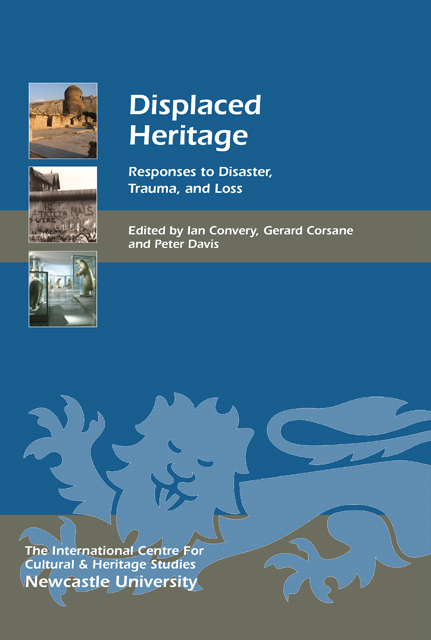Book contents
- Frontmatter
- Contents
- List of Illustrations
- Acknowledgments
- List of Abbreviations
- Preface
- Introduction
- Displaced Heritage: Histories and Tourism
- Displaced Heritage: Trauma, Confinement and Loss
- Displaced Heritage: Lived Realities, Local Experiences
- Displaced Natural Heritage
- Endpiece
- List of Contributors
- Index
- Heritage Matters
24 - Changing ‘Red to Grey’: Alien Species Introductions to Britain and the Displacement and Loss of Native Wildlife from our Landscapes
Published online by Cambridge University Press: 24 February 2023
- Frontmatter
- Contents
- List of Illustrations
- Acknowledgments
- List of Abbreviations
- Preface
- Introduction
- Displaced Heritage: Histories and Tourism
- Displaced Heritage: Trauma, Confinement and Loss
- Displaced Heritage: Lived Realities, Local Experiences
- Displaced Natural Heritage
- Endpiece
- List of Contributors
- Index
- Heritage Matters
Summary
‘Squirrels, beware, beware; Red squirrel run!…’ – Joseph Langland (1963)
Introduction
In our hearts and minds we associate and often inextricably link local features and places, or the passing of the seasons, with the reproductive status of plants or the appearance of familiar animals – whether these are the first flowering messengers of spring, such as winter aconites or snowdrops, winged migratory or regular visitors to our bird feeders in the garden, or the haunting and beautiful calls of curlews across the Cumbrian fells in spring. Our feelings for a place and our sense of home do not simply relate to a location – a geography and ‘what people feel, know and do’, to paraphrase Albert Camus – but also to the birds, mammals and plants that we have become familiar with and accustomed to. What I mean is perhaps captured by Michael Longley’s link to Carrigskeewaun in Ireland in his poem ‘Greenshank’ where he says: ‘… If I had to choose a bird call for reminding you, the greenshank’s esturial fluting will do’ (Longley 2011).
In each place, with its local geology, climate and history, a combination of human influences, chance events, natural processes, individual species journeys and their interactions determine its unique character and our experience of it. Places are both physical and emotional (see for example Kahn 1996), and we cherish and cling onto these impressions and memories as we do to the plant and animal species that belong to them. These sentiments are also inherent in the choice and use of words that describe our efforts to ‘conserve’ wildlife. The very definition of ‘conservation’, to cite The Collins English Dictionary, is: ‘the act of conserving or keeping from change...’ (Hanks 1986). In many ways, the act of conservation is to apply or try to impose static concepts on processes that have always been in flux and changing, albeit over timescales that are usually beyond our normal frame of reference. The Greek philosopher Empedocles, who lived in the west of Sicily around 492–432 bc, acknowledged life’s constant change. He imagined and spoke of cosmic cycles with an alternating pattern of unity and plurality (Osbourne 2004). Change is also reflected in the landscapes and rocks around us.
- Type
- Chapter
- Information
- Displaced HeritageResponses to Disaster, Trauma, and Loss, pp. 265 - 272Publisher: Boydell & BrewerPrint publication year: 2014
- 1
- Cited by

